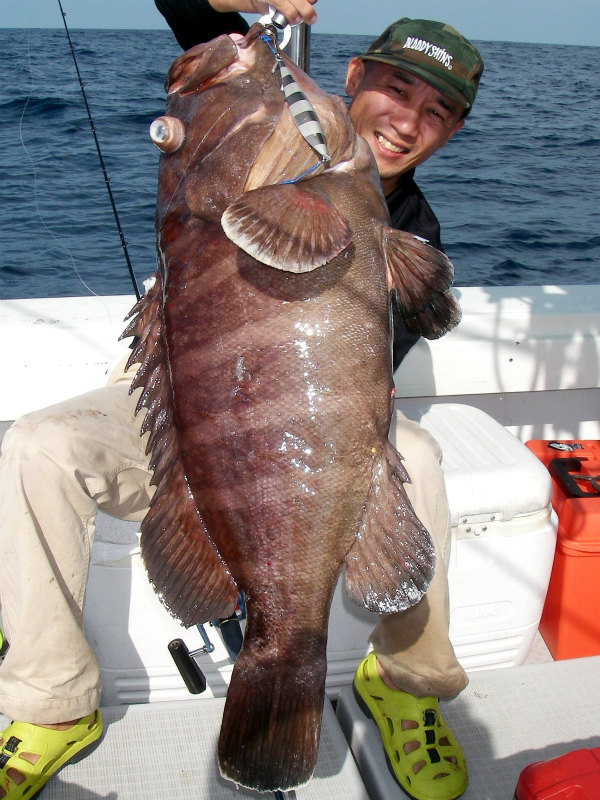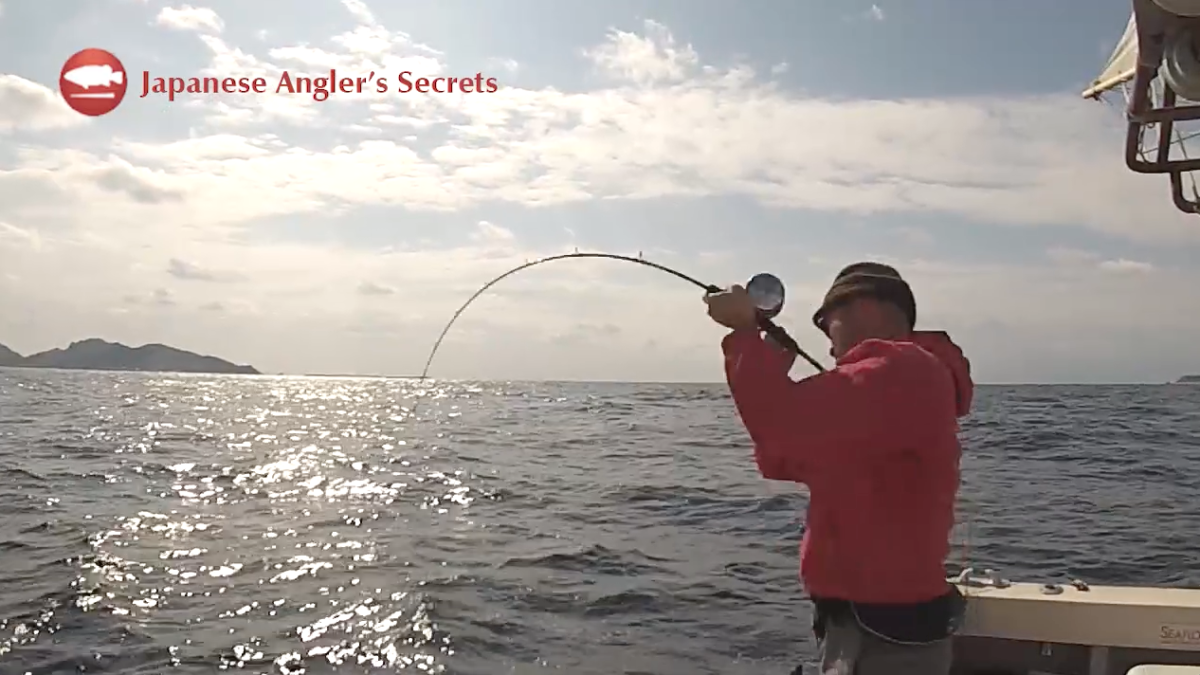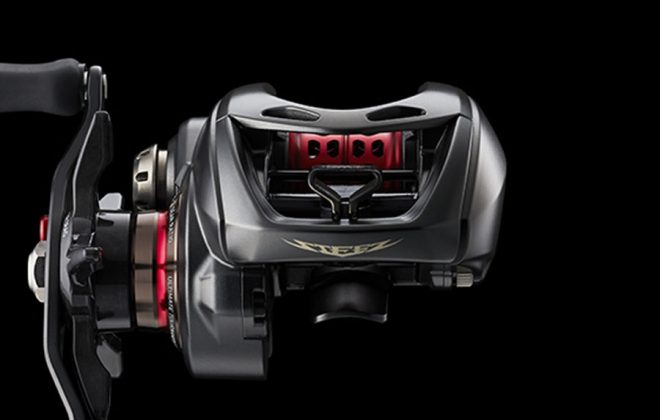What is “Slow-Pitch” Jigging?
This is the state-of-the-art jigging techniques that has been spreading all around Japan and elevating the game of jigging to another dimension. The concepts and techniques have been created by a man named Norihiro Sato. I learned jigging from watching his DVDs. He is my Sensei.
If you know jigging as what it used to be (or see “What is different from hi-speed jigging?“), you think, “Jigging is tough!” Jigging used to be a hard muscle work-out. It’s still an exciting game and it does work in a lot of situations, but on the other hand, it’s a fact that a lot of people have tried jigging and never come back.
But jigging looks totally different in this video. It’s all in Japanese, so if you don’t understand, just take in as much visual information for now. It is my intension to share the principles and techniques throughout this website.
Slow Pitch Jigging by Norihiro Sato
Looks easy?
Well, it is really easy in terms of that you don’t have to torture your muscles.
If you know the old way, you might be wondering “How could possibly a fish bite the jig like that?”
Slow pitch jigging works!
- It works for a wider range of target fish. (From fast-swimming pelagic to demersal fish
- It works for a wider range of fish activity. (Not only when the fish is active, but also when they are not active.)
- It works for a wider range of sea conditions.
- It catches more fish.
Well, when the fish is active and you are fishing in the place where the fish is, any methods could work.
One time I was helping a fellow angler pulling his catch onto the boat, leaving my jig hanging in the water. When I returned I saw my rod fishing on its own. It was a small tuna. Many people believe that they need to move the jig super fast to catch it. But the boat was only rocking and dancing the jig and this fish took it.
But the fish is not active all day. In fact, in most places the active time lasts about 2 to 3 hours at one time, and it only happens a couple of times a day. When they are not active, you need to come up with something different. Slow Pitch Jigging came out of that idea. Sato Sensei tried to figure out how to catch a fish when everyone else is not catching, and how to catch one fish more than anyone else on the boat.
How Does it Work?

Predators always look for easy targets to feed on. The easier the prey is, the better the hunting is. It’s an instinct.
Crippled bait fish make random movements, they dash and stop, dart in irregular directions, make flashing actions, and fall to bottom. In the ocean ecosystem, going downward is a sign of weakness, either it’s not being able to swim or it’s hiding for cover.
This is how the slow pitch jigging is trying to attract the target fish.
Slow pitch jigging is not slow reeling. It is a continuous sequence of stop and go in each pitch. It’s about 1 pitch per second. That tempo is very slow compared to the conventional style of jigging.
1. Reel to make the jig jump
In the moment you give a pitch of reeling, the rod bends nicely to give the smooth upward acceleration to the jig. 1 pitch can be 1 crank, 1/2 turn, or 1/4 turn. You can jerk up the rod a little in each pitch.
2. Hold up and let the rod kick
After a pitch, you hold up the rod. In that moment the rod springs back up, releasing the power in a whipping action so that the jig is tossed up free. When released, the center-balanced jig slides to the side and moves in a horizontal position for a moment. It is when the jig is on its side that the chasing fish comes up for a bite.
3. Let the jig fall
You bring down the rod with half the reeling or not reeling at all. Let the jig fall on its own. If you reel half on the way down and the half on the way up, the jig keeps dancing upward with suspension on its side in between. If you don’t reel on the way down, the jig free-falls and does its own built-in actions on the way down. This is also a popular moment for a bite.
4. Reel to pick up the jig and jump again
Just before you feel the jig weight at the end of the fall, pick it up with your reeling and jerking the rod to give another pitch. This might be a moment that you realize that a fish made a bite in the previous step, during the fall. You can change all kinds of different actions to your rod, speed, length, rhythm, timing and the combinations of all kinds.
To see more slow pitch application.
>> How to make actions in Slow Pitch Jigging
Let the jig swim and fall on its own

You never know what triggers the fish to react to your jig, but basically, slow pitch jigging has learned that it’s when the jig is on its side, the horizontal position, and when the jig is falling, going downward, that it attracts most bites. In other words, these are the moments when the jig is free on its own, when you are not doing anything to the jig. Slow pitch jigging wants to maximize those moments. You do less. Get the jig horizontal. Let it swim on its own. And let it fall on its own.
This method has achieved tremendous results with all kids of fish. The groupers, codfish, rockfish and other bottom fish used to be not much the targets for the conventional style of jigging. But now those delicious fish are our great targets with Slow Pitch Jigging. Tunas, amberjacks, yellowtails and other fast-swimming fish also like this slow moving and falling jigs, too.
The most essential part of Slow Pitch Jigging
Stay vertical
It is essential to stay in a vertical alignment with your jig. Almost everything we do in the setup and the boating is primarily to serve this purpose. And it is when we can’t stay vertical that the slow pitch does not work. Well, at least you need a great deal of adjustments. Otherwise, in the non-vertical alignment, hi-speed jigging may work better.
>> Setting up the Slow-Pitch Jigging
The most fun part of slow pitch jigging (SPJ), I think, is that you have so many tactical choices. The slow pitch principles teach you to become aware of the jig movements. And the awareness enables you to change something when it is not working. You have so many choices. You can change the rod, the reel, the jig type and the jig weight, the line, the leader, the rings, the hooks, the assist line, your application of reeling and jerking. The combinations are unlimited, and they make differences. It’s a bit complicating first. You need to study to really understand it. You may need to let go of some ideas you have been holding. You cannot be successful by just buying SPJ jigs and SPJ rods. It took me 2 years to really understand this game. It is my intension to share what I understand to help you start this exciting game.
I really hope this website will help you understand, enjoy, and go deeper into the game as much as I do.
Hope the information helps you! Good luck!
Related Posts
18 Comments
Leave a Reply Cancel reply
Categories
- 1. SPJ (57)
- 1-1. Principles (9)
- 1-2. Techniques (11)
- 1-3. Setup (17)
- 1-4. FAQ (19)
- 1-5. Tackles (3)
- 1-6. Video Gallery (2)
- 2. Other Offshore Games (5)
- 3. Fishing Report (105)
- 3-1. Totos (25)
- 3-2. Readers (72)
- 4. Fish Cooking (19)
- 4-1. Iki-Jime (3)
- 4-2. The Art of Sashimi (5)
- 4-3. Recipe (7)
- 4-4. Seasoning (3)
- 5. Fishing Charter (6)
- Fish (12)






Love the whole idea and concept.
Can’t wait to put it into praactic over the seamounts around Samoa
Tight Lines & Burnin Thumbs
Greg
Thank you Greg for stopping by. I’m happy that you liked the content.
Slow Pitch Jigging is the most growing fishing game in Japan right now. It’s still new. In every seasons come out the new jigs, new rods, all the other gears, the tactics and the skills. Try it out in your ocean, one the the richest in the world. Good luck and stay tuned!
Totos
Hi Totos,
I wasn’t sure which section of your website to post this so I chose here! Do the techniques you have here work with the inchiku / madai style slow jigs? Or do you fish them a different way?
Thanks!
Brad
Hi Brad.
Thank you for your interest in this game.
Inchiku jig is a total different concept. I’m not sure what you mean by “madai style slow jig”.
But slow pitch can work with any center balanced jigs with one side shaped differently to the other. And you can even forget about the slow pitch. The principals and strategies you learn from this game can be applied to any style of vertical games.
It’s all about being aware of the situation and making your own choices of tactics.
[…] and techniques are included, for example the fishing jigging technique known as the slow pitch jigging and techniques […]
Hai Totos..
I wasn’t sure which section of your website to post this so I chose here!… My name Dill, I’m from Malaysia… home of light jigging. Malaysia have a lot of jigging feild… and also a lot of species like amberjack, travallies, snapper, groupper and many more. That why a lot of Singaporean also come to Malaysia to after these species using jigging method. Befor
I certainly a speed jigging lovers. but after reading your blog I am very impressed with this technique. I was very lucky because after searching for almost 3 months, I managed to get the EverGreen Poisedon PSLJ 603-3 although the price is very expensive (Japanese Yen 56,000). The only problem in Malaysia is not much slow jig sell in the market. There is no SFC or Falcon sell here. Only Shout you can find here. This include EverGreen rod…but very hard to find although we have distributer in Malaysia.
Back to technique, what is meant by Strong Setting, Medium Setting, Soft Setting? Can you explain me further?
For example, I often fishing at a depth of 70m. Fish targets are snapper, grouper and trevallies. Sometimes the current speed is 0.5 – 1.5 knots. Jigging technique that is often used here is jigging drift (the boat is not anchor). What is the ideal setting for me to use?
Thank you, Fadill, for your interest and questions.
Your questions are becoming more common and I’m realizing I’m not making myself clear. Let me have a few more days and I will write a post about it.
Malaysia sure sounds like an interesting place to visit!
But you should consider getting a sea-anchor. Being vertical would elevate your game. That is probably the easiest way to catch more fish than the others there.
http://anglers-secrets.com/v2020/faq-why-does-it-have-to-be-so-vertical-for-slow-pitch-jigging/
Stay tuned!
Dear Totos, I must say it is a very nice blog you got here. Congrats!! I’m from totally different side of the globe. Slovenia (Europe). We mostly fish in Adriatic sea of Croatia. A lot of islands nice diverse shore and depth to 50 m (100m of shore). Let’s talk techniques now. Latelly I started with shore jigging in this area. I think it is not so different from vertical jigging except you move, cast and walk a lot, which is why I prefer it. I do use jiggs from 50 – 80 gramms, of different shapes. For example: Jigging Master Ocean God, M&W Tissot, Ghost jig and Knife jig, FCL Labo SLC and FTC jiggs, Uzu Oreno Shabba jiggs, Molix Jugulo,…Now the question, some of those jiggs (teoretically) should be fished with short sharp rips in conjunction with long pauses! What does this mean? Is this similar to the frase (video you posted) slow pitch-jerks. For example FTC Labo (SLC and FTC) jiggs should be fished with this technique (short sharp rips) as their shape is wide and short. And with jiggs of long, narrow and pointy shape, such as JM Ocean God, M&W Ghost jig and Tissot, should we fished with speed technique, or? Would you be so kind and let me know. Thank you for your time and keep up the good work!! With Best Regards from Slovenia.
Hi Gregor.
Thank you very much for your compliments and encouragements.
I’m not so sure what you are asking, but I’ll try my best to share what I think.
What is the difference between hi-speed jerks and short sharp rips? It’s the moment of suspension between pitches, isn’t it? I also think that short sharp rips involve more acceleration in your reel turn.
What is the jig doing during the moment of suspension? … It’s released from the accelerating pull, and it’s swimming on its own for a moment. It can be swimming toward different directions, or maybe twirling. This is when the fish makes a bite. Because it may look hesitating, hunting (off guard), or crippled.
What is the long pause? What is the jig doing when you give a long pause? … It’s falling. In a vertical game like slow pitch, long pause means that you are just hanging the jig. But in the shore jigging, you are not vertical. You are diagonal. You have much line slack in the water. When you pause, the jig falls with flashing, waving, rocking, spiraling or like a falling leaf. This is when the fish makes a bite. Because descending is a sign of weakness, and easy targets always fall from above.
What you are doing with all this is to create the change of pace and the change of directions in jig movements. Compare it with one steady straight pull. Play with a cat with a straw and see what movement catches her attention and triggers her to attack.
Hope it helps!
Hi Totos, what can I say? Professionally said!! Thank you. So, is it there a difference between jiggs for slow pitching and fast-speed jigging? I suppose, for slow jigging are shorter and wider jiggs and for speed jigging are longer and thinner jiggs. Am I right, or you can do both (slow and fast jigging) with both shape of jiggs (shorter-wider and longer-thinner)? Thank you once again and warm greetings from this part of the globe. Gregor
Hi Gregor.
Thank you for your enthusiasm.
Actually slow pitch jigging works with both types of jigs. Slow pitch emphasizes in suspension and falling. Leaf shaped jigs have been developed to maximize that effects. But a center-balanced long jig can do just as well. As a matter of fact, long jigs like Seafloor Control Messiah and Deepliner Spy have proved to be so effective in this method.
On the other hand, hi-speed jigging emphasizes in lifting. Leaf shaped jigs would not follow well and you’ll be tired of lifting it in all the water resistance.
hi totos
i m using maxel f50 transformer reel with maxel 684 rod
braid shimano kariki 0.28
fisihing in 40 :60 m water
what should i use for the leader .. and what about jiggs weight to use ?
thanks
There you are.
I don’t know Maxel rod. I assume it’s power 4 rod (equivalent to Slow Jerker 603-4). Your line is pretty heavy (it catches more water for line slack). And I assume you are free-drifting.
I would use the jig weight range from 150g to 200g. Not the fat fall jigs like Gawky. Something that falls fast and good for uplifting actions, like Spunky, Arc, Cranky.
The leader should be equal strength to your PE or heavier.
hi tatos
is the gear ratio 1:5.8 ok for slow pitch jigging
thanks
The speed is more important in slow pitch jigging. What I mean is retrieve length per crank.
http://anglers-secrets.com/v2020/reels-for-slow-pitch-jigging/
Hi mas totos, what do you think about using circle hook for slow jigging. thank you
Hi Galih.
Negative. In bait fishing, the fish bites on the hook. Not necessarily so in jigging. The fish pulls the jig. The angler counter-pulls the jig. And the hook slides on the fish skin, and the hook point finds a place to hook into. You can try and see for yourself. Slide the hook slowly on your skin in different angles and see how the point finds a hook.
Circle hook is a fish friendly hook. But I think it’s too friendly for the game of jigging.
There’s an article about the hook here.
http://anglers-secrets.com/v2020/in-depth-study-on-hooks-for-slow-pitch-jigging/